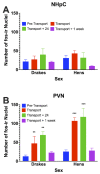Transportation Stress Increases Fos Immunoreactivity in the Paraventricular Nucleus, but Not in the Nucleus of the Hippocampal Commissure in the Pekin Duck, Anas platyrhynchos domesticus
- PMID: 36428440
- PMCID: PMC9686473
- DOI: 10.3390/ani12223213
Transportation Stress Increases Fos Immunoreactivity in the Paraventricular Nucleus, but Not in the Nucleus of the Hippocampal Commissure in the Pekin Duck, Anas platyrhynchos domesticus
Abstract
Commercial poultry undergo transportation during their life, and the effects of transportation can negatively impact poultry production and welfare. In order to maintain physiological homeostasis, the hypothalamic−pituitary−adrenal axis (HPA) works to respond to stressors. Previous studies by others have shown contradictory effects of transportation on corticosterone release. However, recent studies from our lab and by others have shown that cortisol may also be an important hormone in the avian HPA. The purpose of our current study was to determine the effects of transportation stress on the stimulation of brain nuclei that regulate the HPA in birds, and on glucocorticoid (GC) secretion. To test this hypothesis, we collected blood and brain samples from developer drakes and hens (N = 10 per sex/time point): 24 h prior to transportation, immediately after transportation, 24 h after transportation, and 1 week after transportation. Serum GC levels and fos immunocytochemistry (ICC) within the nucleus of the hippocampal commissure (NHpC) and paraventricular nucleus (PVN) were measured. Data were analyzed using a two-way ANOVA. Post hoc analysis was completed using a Fisher’s PLSD with a p < 0.05 considered significant. We observed a sex difference (p < 0.05) in both corticosterone and cortisol secretion in Pekin ducks, although neither GC showed a significant increase in secretion associated with transportation. However, we did observe a significant (p < 0.05) increase in fos-like immunoreactivity for 24 h in the PVN, but not in the NHpC. Further studies are required to determine the specific role that GCs play in the avian stress response and the short-term stressors that could have long-term physiological effects on birds.
Keywords: corticosterone; cortisol; nucleus of hippocampal commissure; paraventricular nucleus; sex difference.
Conflict of interest statement
The authors have no conflict of interest to declare.
Figures



Similar articles
-
Sex differences in serum glucocorticoid levels and heterophil:lymphocyte ratios in adult pekin ducks (Anas platyrhynchos domesticus).Gen Comp Endocrinol. 2022 Feb 1;317:113975. doi: 10.1016/j.ygcen.2021.113975. Epub 2022 Jan 4. Gen Comp Endocrinol. 2022. PMID: 34995644
-
Differential delayed responses of arginine vasotocin and its receptors in septo-hypothalamic brain structures and anterior pituitary that sustain hypothalamic-pituitary-adrenal (HPA) axis functions during acute stress.Gen Comp Endocrinol. 2020 Jan 15;286:113302. doi: 10.1016/j.ygcen.2019.113302. Epub 2019 Oct 14. Gen Comp Endocrinol. 2020. PMID: 31622604
-
Possible roles of brain derived neurotrophic factor and corticotropin releasing hormone neurons in the nucleus of hippocampal commissure functioning within the avian neuroendocrine regulation of stress.Stress. 2021 Sep;24(5):590-601. doi: 10.1080/10253890.2021.1929163. Epub 2021 May 28. Stress. 2021. PMID: 34003076
-
The stress system in the human brain in depression and neurodegeneration.Ageing Res Rev. 2005 May;4(2):141-94. doi: 10.1016/j.arr.2005.03.003. Ageing Res Rev. 2005. PMID: 15996533 Review.
-
Stress-induced norepinephrine release in the hypothalamic paraventricular nucleus and pituitary-adrenocortical and sympathoadrenal activity: in vivo microdialysis studies.Front Neuroendocrinol. 1995 Apr;16(2):89-150. doi: 10.1006/frne.1995.1004. Front Neuroendocrinol. 1995. PMID: 7621982 Review.
Cited by
-
Sex differences in blood pressure responses of Pekin ducks to sound stimuli and conspecific vocalizations.Poult Sci. 2025 Feb;104(2):104735. doi: 10.1016/j.psj.2024.104735. Epub 2024 Dec 26. Poult Sci. 2025. PMID: 39740496 Free PMC article.
-
Transportation increases circulating corticosterone levels and decreases central serotonergic activity in a sex dependent manner in Pekin ducks.Poult Sci. 2025 Jan;104(1):104494. doi: 10.1016/j.psj.2024.104494. Epub 2024 Nov 2. Poult Sci. 2025. PMID: 39541859 Free PMC article.
References
-
- Kadhim H.J., Kang S.W., Kuenzel W.J. Differential and Temporal Expression of Corticotropin Releasing Hormone and Its Receptors in the Nucleus of the Hippocampal Commissure and Paraventricular Nucleus during the Stress Response in Chickens (Gallus Gallus) Brain Res. 2019;1714:1–7. doi: 10.1016/j.brainres.2019.02.018. - DOI - PubMed
Grants and funding
LinkOut - more resources
Full Text Sources
Miscellaneous

